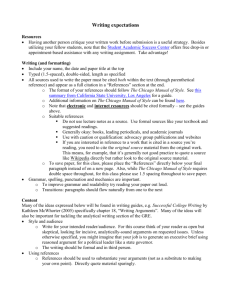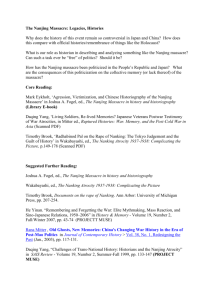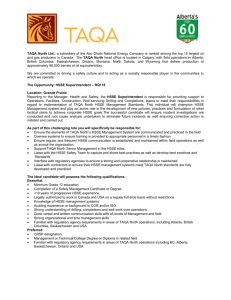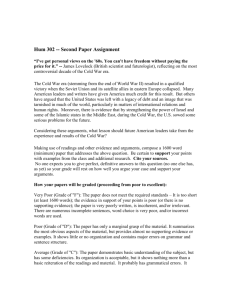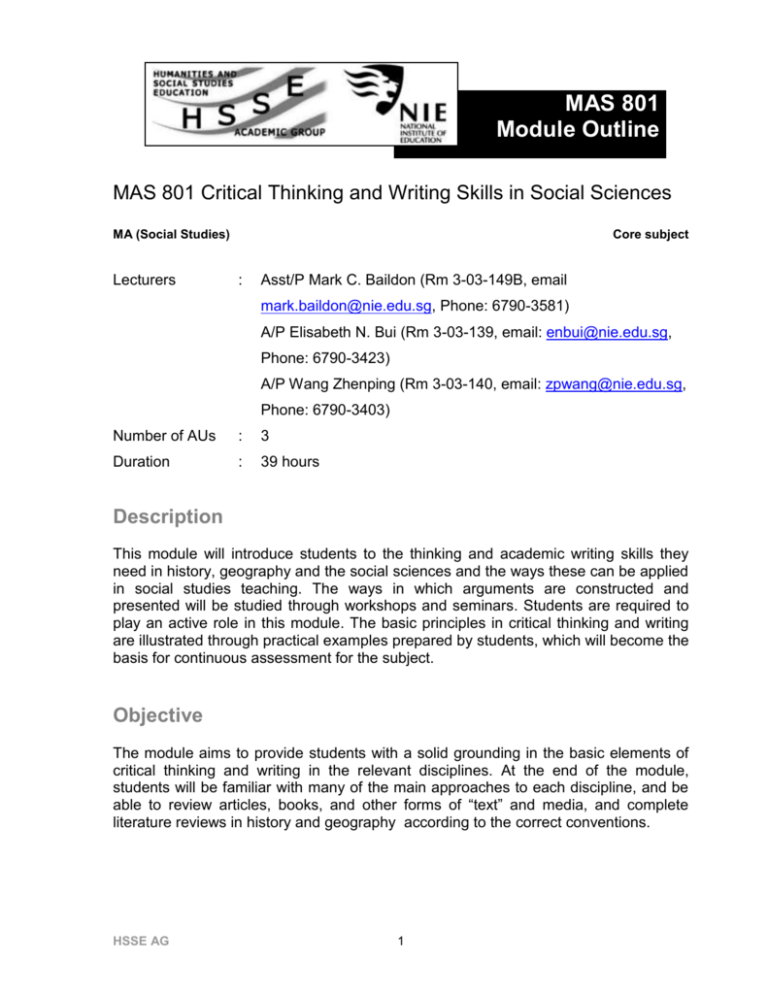
MAS 801
Module Outline
MAS 801 Critical Thinking and Writing Skills in Social Sciences
MA (Social Studies)
Lecturers
Core subject
:
Asst/P Mark C. Baildon (Rm 3-03-149B, email
mark.baildon@nie.edu.sg, Phone: 6790-3581)
A/P Elisabeth N. Bui (Rm 3-03-139, email: enbui@nie.edu.sg,
Phone: 6790-3423)
A/P Wang Zhenping (Rm 3-03-140, email: zpwang@nie.edu.sg,
Phone: 6790-3403)
Number of AUs
:
3
Duration
:
39 hours
Description
This module will introduce students to the thinking and academic writing skills they
need in history, geography and the social sciences and the ways these can be applied
in social studies teaching. The ways in which arguments are constructed and
presented will be studied through workshops and seminars. Students are required to
play an active role in this module. The basic principles in critical thinking and writing
are illustrated through practical examples prepared by students, which will become the
basis for continuous assessment for the subject.
Objective
The module aims to provide students with a solid grounding in the basic elements of
critical thinking and writing in the relevant disciplines. At the end of the module,
students will be familiar with many of the main approaches to each discipline, and be
able to review articles, books, and other forms of “text” and media, and complete
literature reviews in history and geography according to the correct conventions.
HSSE AG
1
Organization of module
Students will meet with lecturer once a week for three hours for lecture, presentation
and group discussion.
Schedule of module
Duration of the course: 14 Weeks (starting on 27 July)
Time and Venue for Lectures: 6:00-9:00 PM at Teachers Network
Sessions
Week no.
1.
2.
3.
4.
5.
6.
7.
8
9.
10.
11.
12.
13.
Topic
Introductions to critical thinking and writing; Understanding
critical and disciplinary discourses and theoretical frameworks:
critical and disciplined inquiry and literacy practices
Week 1 PowerPoint
Week 1 Assignment
Disciplinary discourses in schools: Classrooms as communities
of practice for critical thinking and writing in social sciences
Critical thinking and writing in social studies/history
Critical thinking and writing about space and place
Critical assessment of biography as a form of historical study
(I): Mao Zedong in the Long March
Critical assessment of biography as a form of historical study
(II): Mao Zedong in the Cultural Revolution
Using documentary as a source of historical study
Literature review as a means for critical scholarship
Critical thinking in Geography: New Orleans (NO) after hurricane
Katrina: Should NO be rebuilt?
Investigating the historical context of NO and defining the
geographical /spatial context of the problem
Beyond NO: Is there a broader context to the NO/hurricane
Katrina story?
Investigating the social context of the NO/hurricane Katrina
story
Review of the module
Assessment
Students will be assessed on the basis of assignment (60%), presentation and
discussion (30%), and participation (10%).
HSSE AG
2
Assignment
1.
You will submit three short essays, each of 1,000 words at the end of week 4
(17 August), week 8 (14 September), and week 12 (12 October).
Essay #1: Critical Response Essay
2.
Please consult your lecturers for essay topics.
FORMAT OF ASSIGNMENT
a)
The length of the essay should be approximately 1,000 words.
b)
It should be typewritten (double-spaced) on A4-size paper.
c)
Quotations must be acknowledged in the footnotes.
Books that have been used as reference must be listed (in alphabetical
order of the authors’ last names) in the bibliography.
d)
The title Page: The Title Page should include the following#Title of Essay
#Name of Student and Year of Intake
#Program
#Name of Tutor
#Date of Submission
#Name of Address of National Institute of Education
#A Statement that reads as follows: "This assignment is submitted in
partial fulfilment of the requirements for the MA (SS) course.”
e)
3.
A bibliography
Plagiarism
Plagiarism is an academic offence. It is cheating of the most serious kind. It will be
treated firmly. Even if only a small proportion of your assignment submitted exhibits
plagiarism, this can justify a zero mark. If you are not sure what constitutes
plagiarism, please read pages 12-13 of History Handbook 2001-2002, HSSE, or
discuss this matter with your lecturer.
HSSE AG
3
The following are the three main kinds pf plagiarism:
Plagiarism of ideas. All ideas and arguments taken from other works of
any kind must be footnoted in the form explained on page nine. You may
not pass off any work from another person, book, the internet, or any
other source whatsoever, as your own.
Plagiarism of references. In this case you read work x, which cites work
y. But you cite work y as if this was your source, though you have not
read it. This is fraud, in that you are making a false claim to having read
y. The correct action is to footnote it as ‘work y, as cited in x’. See page
nine above for an example.
Plagiarism of words. If you take the exact form of words from another
work, you must always put those words in quotation marks. Even if you
acknowledge the source in a footnote, it is not acceptable to use the
precise
form of words of the original without quoting them. Nor is it
acceptable to use the original sentences, while changing the occasional
word. You may paraphrase short sections of another work, but
“paraphrase” means genuinely putting such sections into your own
words. As a rule of thumb, if you repeat more than four or five words
from another work together, then they must not only be footnoted, but
must in all circumstances go in quotation marks as well. If you are in
any doubt at all, it is your responsibility to ask your lecturer.
HSSE AG
4
Recommended Readings
Week1-week4
Alston, K. (1995). Begging the question: Is critical thinking biased? Educational Theory,
45(2), 225-233.
Black, J. (1997). Maps and politics. Chicago: Chicago University Press.
Booth, A. (2003). Teaching history at university: Enhancing learning and understanding.
New York: Routledge.
Burbules, N.C. & Berk, R. (1999). Critical thinking and critical pedagogy: Relations,
differences, and limits. In T.S. Popkewitz & Lynn Fendler (Eds.) (1999). Critical
theories in education: Changing terrains of knowledge and politics, pp. 45-65.
Calder, L. (2006). Uncoverage: Toward a signature pedagogy for the history survey.
The Journal of American History, March 2006, 1358-1370.
Evans, R. W. & Saxe, D. W. (Eds.), Handbook on teaching social issues: NCSS bulletin
93. Washington, D.C.: National Council for
Social Studies.
Fay, B. (1987). Critical social science. Ithaca, NY: Cornell University Press.
Gaddis, J. L. (2002). The Landscape of history: How historians map the past. New York:
Oxford University Press.
Harley, J. B. (1988). Maps, knowledge, and power. In D. Cosgrove & S. Daniels (Eds.), The
iconography of landscapes: Essays on the symbolic representation, design, and use
of past environments. Cambridge, U.K.: Cambridge University Press.
Himmelfarb, G. (1989). Some reflections on the new history. American Historical
Review 94(3), 661-670.
Holt, T. (1990). Thinking historically: Narrative, imagination, and understanding.
College Board.
Jenkins, K. (1991). Re-thinking history. London: Routledge.
Jenkins, K. (2003). Refiguring history: New thoughts on an old discipline. NY:
Routledge.
Kaiser, W., & Wood, D. (2001). Seeing through maps: The power of image to shape our
HSSE AG
5
world view. Amherst, MA: ODT.
Levstik, L. (1985). Literary geography and mapping. Social Education, 49 (1), 38—43.
Levstik, L., & Barton, K. (2001). Doing history: Investigating with children in
elementary and middle schools. Mahwah, NJ: Erlbaum.
Massey, D., & Jess, P. (Eds.) (1995). A place in the world? Places, cultures, and
globalization. NY: Oxford University Press.
Mitchell, D. (2000). Cultural geography: A critical introduction. Malden, MA: Blackwell
Publishing.
Monmonier, M. (1991). How to lie with maps. Chicago: University of Chicago Press.
Monmonier, M. (1995). Drawing the line: Tales of maps and cartocontroversy. New York:
Henry Holt & Co.
Nisbett, R.E. (2003). The geography of thought: How Asians and Westerners think
differently…and why. NY: The Free Press.
Rosenau, P.M. (1992). Postmodernism and the social sciences: Insights, inroads, and
intrusions. Princeton, NJ: Princeton University Press.
Segall, A. (1999). Critical history: Implications for history/social studies education.
Theory & Research in Social Education. 27(3), 358-374.
Segall, A. (2003). Maps as stories about the world. Social Studies and the Young
Learner,
16(1), 21-25.
Segall, A., Heilman, E.E., & Cherryholmes, C.H. (Eds.) (2006). Social studies - The next
generation: Re-searching in the postmodern. NY: Peter Lang.
Seixas, P. (1993). The community of inquiry as a basis for knowledge and learning: The
case of history. American Educational Research Journal. 30(2), 305-324.
Soja, E.W. (1989). Postmodern geographies: The reassertion of space in critical social
theory. NY: Verso.
Stearns, P.N., Seixas, P., & Wineburg, S. (Eds.) (2000). Knowing, teaching, and learning
history. New York: New York University Press.
Walters, K.S. (Ed.) (1994). Re-thinking reason: New perspectives in critical thinking.
Albany, NY: SUNY Press.
Wineburg, S. (2001). Historical thinking and other unnatural acts: Charting the future of
HSSE AG
6
teaching the past. Philadelphia, PA: Temple University Press.
Books on the Craft of Scholarship
Five books that might be useful for students interested in the craft of writing and
scholarship are the following:
Booth, W.C., et. al. (1995). The craft of research. Chicago: University of Chicago Press.
This book provides a fairly systematic account of how to carry out research by
starting with the problem of how to conceptualize a study and formulate a
question and how to deal with basic steps in the research process: dealing with
data, using sources, constructing valid claims based on evidence, formulating
arguments, representing data, organizing research reports, and making strong
arguments.
Becker, H. S. (1998). Tricks of the trade: How to think about your research while you’re
doing it. Chicago: University of Chicago Press.
Becker focuses on intellectual “tricks of the trade’ that researchers use to make
sense of their data – asking good questions, following productive angles for
analysis, using logical strategies, and avoiding common mental traps. He
discusses the use of imagery (metaphors, images of how things work), sampling
(data used for persuasion, validity, representation), concepts (uses of theory,
approaches to conceptualizing what you see), and logic (considering the full
range of possibilities, looking for what’s missing). Tricks include treating the
exception as the rule and exploring assumptions behind your observations.
Lasch, C. (2002). Plain Style: A Guide to Written English. Philadelphia: University of
Pennsylvania Press.
Lasch is an American social historian and critic who wrote this book hoping to
train students in the “historiographical arts.” He sees writing as an art of argument
and plain speaking, the ability to bring someone around to your point of view. He
wrote this as a guide for university students.
Williams, J. M. (1990). Style: Toward clarity and grace. Chicago: University of Chicago
Press.
Williams provides strategies on how to write in a clear, concise, effective, and
graceful manner. As Williams explains in his introduction, “I want to do more than
just urge writers to ‘Omit Needless Words’ or ‘Be Clear.’ Telling me to ‘be clear’ is
like telling me to ‘hit the ball squarely.’ I know that. What I don’t know is how to do
it. To explain how to write clearly, I have to go beyond platitudes.” This is what he
tries to do. He offers basic principles of good writing, along with examples of the
application of these principles.
Weston, A. (1992). A rulebook for arguments (2nd ed.). Indianapolis: Hackett Publishing.
Weston offers a concise and understandable outline of basic rules for
constructing arguments. His rules are easy to follow and his examples show what
HSSE AG
7
good and bad arguments look like in practice. He focuses on creating effective
short arguments and how to extend this to writing arguments that extend over a
full-length paper or book.
Web Resources
Writer’s Toolbox for Building Arguments: This is the companion Web site designed to
accompany Writing Arguments, Brief, and Concise Edition, 2nd Edition, by John D.
Ramage, John C. Bean, and June Johnson. Created for students and instructors, this
site both highlights key concepts and resources of Writing Arguments and offers new
material that builds on and extends these resources. Especially useful is the “Writer's
Toolbox for Building Arguments,” which provides reading and writing strategies that can
help you with many different writing projects.
http://cwabacon.pearsoned.com/bookbind/pubbooks/ramage2_ab/chapter18/deluxe.html
The University of North Carolina’s Writing Center Resources for Writing: This site
provides handouts and tools for writing that include writing arguments, thinking about
your audience, writing introductions and conclusions, using evidence and
counterarguments, reading critically, and writing papers in specific fields such as history,
political science, sociology, and philosophy. It also includes a section on “Writing in
History.” http://www.unc.edu/depts/wcweb/handouts/argument.html
http://www.unc.edu/depts/wcweb/handouts/history.html
A Brief History of Critical Thinking: Provided by The Critical Thinking Community, this
site gives a good overview of critical thinking and its history. The site also includes “35
Dimensions of Critical Thought.”
http://www.criticalthinking.org/aboutCT/briefHistoryCT.shtml
http://www.criticalthinking.org/resources/TRK12-strategy-list.shtml#s16
The National History Project Analysis Guides: An excellent site that provides
historical thinking and analysis guides, background on history’s habits of mind, and
heuristics for doing historical analysis and interpretation.
http://www.history.ilstu.edu/nhp/terminology.html
History Matters: A project of the American Social History Project/Center for Media and
Learning that provides guides and interactive activities for analyzing a range of primary
sources (photos, oral histories, maps, films, letters, diaries, numbers, ads, etc.).
“Scholars in Action” segments show how scholars puzzle out the meaning of different
kinds of primary sources, allowing students to try to make sense of documents and then
providing audio clips (or text) in which leading scholars interpret the document and
discuss strategies for overall analysis. http://historymatters.gmu.edu
US National Archives and Records Administration’s Digital Classroom: NARA
provides a set of document analysis worksheets for several different primary sources
(written documents, photos, cartoons, posters, maps, artifacts, sound recording, and
motion pictures).
HSSE AG
8
http://www.archives.gov/digital_classroom/lessons/analysis_worksheets/worksheets.html
The Library of Congress’ “The Learning Page”: The Library of Congress provides
guides, activities, and lessons to help students learn about primary sources and how to
analyze and interpret primary sources. It provides questions to guide students’ analyses
of primary sources, a time and place rule, and a bias rule to support student thinking
about primary sources.
http://lcweb2.loc.gov/ammem/ndlpedu/lessons/psources/pshome.html
Thinking Critically about Discipline-Based World Wide Web Resources: This UCLA
College Library site offers several points to consider regarding Web sites for subject
disciplines. http://www.library.ucla.edu/libraries/college/help/critical/discipline.htm
Thinking Critically about World Wide Web Resources: This site offers several
questions for evaluating the content, source, and design of Web sites.
http://www.library.ucla.edu/libraries/college/help/critical/index.htm
Critical Viewing and Critical Thinking Skills: The Center for Media Literacy provides
many useful resources for visual literacy, teaching media literacy, and deconstructing
media representations. http://www.medialit.org/reading_room/article202.html
Tolerance.Org Site Check: Site Check walks the reader of a Web site through a series
of questions to help evaluate the appropriateness of a specific Web site for classroom
use or for research purposes. At the end of the tutorial, students can print their
assessment of the site for future reference. The questions can also be downloaded as a
pdf. file.
http://www.tolerance.org/teach/web/site_check/index.jsp
5 Criteria for Evaluating Web Sites & Critically Analyzing Information Sources:
Guides provided by Cornell University’s libraries.
http://www.library.cornell.edu/olinuris/ref/webcrit.html
http://www.library.cornell.edu/olinuris/ref/research/skill26.htm
Tools for Reading the World: NoodleTools offers tools, guides, and activities for 21st
century literacies, such as visual literacy, historical literacy, cultural literacy, information
literacy, scientific literacy, and mathematical literacy.
http://noodletools.com/debbie/literacies/21c.html
Johns Hopkins University’s site on Evaluating Information Found on the Internet:
This site discusses the criteria by which scholars in most fields evaluate print
information, and shows how the same criteria can be used to assess information found
on the Internet.
http://www.library.jhu.edu/researchhelp/general/evaluating/index.html
Digital Literacy: Rethinking Education & Training in a Digital World: A site provided
by Portland State University with information about media studies, media literacy,
HSSE AG
9
constructivist learning theories, and curriculum development.
http://digitalliteracy.mwg.org/studies.html
http://digitalliteracy.mwg.org/curriculum/integrating.html
Resources for Studying Propaganda: This site from the Institute for Propaganda
Analysis provides information about common propaganda techniques, questions that
can help students identify these techniques, and examples that students can analyze.
http://www.propagandacritic.com/
UC Berkeley Library’s Finding Information on the Internet: The UC Berkeley Library
provides “A Tutorial: Evaluating Web Pages - Techniques to Apply and Questions to
Ask.” http://www.lib.berkeley.edu/TeachingLib/Guides/Internet/Evaluate.html
Historical Inquiry: This site is part of a project for “scaffolding wise practices in the
history classroom. It provides background information, strategies, tutorials, and
resources for historical inquiry and understanding the past.
http://www.historicalinquiry.com/index.cfm
Critical Media Literacy in Times of War: As the site explains, “this site focuses on U.S.
foreign policy, military invasion and war, because controversies like WAR test the
freedom of expression in a democracy.” It provides modules to help compare domestic
and international reporting, analyze sources, word choice, and point of view, and
examine how different media offer different reporting.
http://www.tandl.vt.edu/Foundations/mediaproject/
Critical Literacy: Produced by the Department of Education in Tasmania, this site
examines elements of Critical literacy as the analysis and critique of the
relationships among texts, language, power, social groups and social practices.
http://www.education.tas.gov.au/english/critlit.htm#howdoes
Week5-week9
Anderson, C. Arnold. “The Utility of the Proposed Trial and Punishment of Enemy
Leaders,” American Political Science Review, 37:6 (December 1943)
Barmouin, Barbara ad Yu Changge. Zhou Enlai: A political life. Hong Kong: The
Chinese University Press, 2006.
Breslin, Shaun. Mao. New York: Longman, 1998.
HSSE AG
10
Brook, Timothy (ed.). Documents on the Rape of Nanking. Ann Arbor, Michigan:
University of Michigan Press, 1999.
Chang, Iris. The Rape of Nanking: The Forgotten Holocaust of World War II. New
York: Basic Books, 1997.
Chang, Jung and Halliday, Jon. Mao, the Unknown Story. New York: Knopf, 2005.
Cohen, Paul. China unbound: Evolving perspectives on the Chinese past. New York:
RoutledgeCurzon, 2005.
---------------. Discovering history in China: American historical writing on the recent
Chinese past. New York: Columbia University Press, 1984.
Chou, Erich. Mao Tse-tung, the Man and the Myth. London: Cassell LTD, 1982.
Dirlik, Arif. Revolution and history: Origins of Marxist historiography in China, 19191937. Berkeley: University of California Press, 1978.
Fogel, Joshua A. The Nanjing Massacre in History & Historiogaphy. Berkeley,
California: University of California Press, 2000.
Jian Bozan et al., A Concise History of China. Beijing: Foreign Languages Press,
1964.
Li, Fei Fei, Sabella, Robert and Liu, David (editors). Nanking 1937, Memory &
Healing. New York: M.E. Sharpe, 2002
Feigon, Lee. Mao, a Reinterpretation. Chicago: Ivan R. Dee, 2002.
Morrison, Donald. “Taking Aim at Mao,” Time, June 13, 2005, pp. 48-49.
Ng, On-cho and Wang, Q. Edward. Mirroring the Past. The writing and use of history
in imperial China. Honolulu: The University of Hawaii Press.
Pritchard, R. John and Zaide, Sonia Magbanua (comps.). International Military
HSSE AG
11
Tribunal for the Far East: The Tokyo War Crimes Trial (22 vols.). New York:
1981–1987.
Schaberg, David. A patterned past: Form and thought in early Chinese historiography.
Cambridge, Mass.: Harvard University Asia Centre, 2001.
Schmidt-Glintzer, H. et al (eds.). Historical truth, historical criticism, and ideology:
Chinese historiography and political culture from a new comparative
perspective. Leidon: E.J. Brill, 2005.
Short, Philip. Mao, a Life. New York: Henry Holt, 1999.
Tam, Yue-him, “To burry the unhappy past: The problem of textbook revision in
Japan.” The East Asian Library Journal, VII:I (1994), pp. 7-42.
Tanaka Masaaki. What Really Happened in Nanking- The Refutation of a Common
Myth. Tokyo: Shekkai Shuppan Inc., 2000.
Wong R. Bin. China transformed: historical change and the limits of European
experience. Ithaca, N.Y.: Cornell University Press, 1997.
Yamamoto Masahiro. Nanking – Anatomy of an Atrocity. Westport, Connecticut:
Praeger Publishers, 2000.
Yang Daqing. The Nanjing Atrocity: The Making of a Twentieth-Century Rashmon. MA
thesis, University of Hawaii at Manoa, 1989.
Yoshida Takashi. The making of “the Rape of Nanking”: The history and memory of
the Nanjing Massacre in Japan, China, and the United States. Oxford: Oxford
University Press, 2006.
Net Resources
Aldric Hama , A re-evaluation of the "genocide" in Nanking: victor's justice Dec 2004,
HSSE AG
12
http://www.jiyuu-shikan.org/e/china/nanking0411-4.html
Askew, David, The Nanjing Incident, Recent Research & Trends electronic journal of
contemporary Japanese studies
http://www.japanesestudies.org.uk/articles/Askew.html
China News Digest Nanjing Massacre Historical Archive
http://www.cnd.org/njmassacre (A Collection of Articles and Photographs related to
the Nanjing Massacre)
Jiangyong Liu, On Correct Understanding of the Historical Issues between China and
Japan. www.china-un.org/eng/zt/af60/t219660.htm
Museum of the Nanjing Massacre http://www.smn.co.jp/gallery/nanjing/
The Distortion and the Revision of History in Post-war Japanese Textbooks, 1945-1998,
Tomochika Okamoto, http://homepage3.nifty.com/ubiquitous
The Nanking Atrocities (An Online Documentary)
http://www.geocities.com/nankingatrocities/
Virtual Memorial Hall of the Victims of the Nanjing Massacre
http://cnd.cnd.org/mirror/nanjing/ (Mirrored from the Chinese University of Hong Kong
site: Contains an excellent list of links to other Nanjing Massacre-related sites.)
Yang Daqing, Convergence or Divergence? Recent Historical Writings on the Rape of
Nanjing. http://.www.historycooperative.org
http://www2.sjsu.edu/depts/itl/graphics/main.html
HTTP://art.bon.com/art/omao.html (quotations of Mao)
HTTP://www-chaos.umd.cdu/history/prc1.html (history of PRC)
HSSE AG
13
VCD
In HSSE collection
BBC People’s century (20th). Disk two: 1997 fast forward (from 15 minutes to 21:18
minutes: reforms in China in the 1980s)
In NIE library:
No rest for the weary: The Cultural Revolution and its origin.
Unfortunate generation: The Cultural Revolution and beyond
Week 11- week13
Bird, J. H. The changing worlds of geography: a critical guide to concepts and methods.
Clarendon Press, Oxford, 1993.
Chandrasegaran, A. and K. Schaetzel. Think your way to effective writing (3rd ed.).
Pearson Prentice Hall: Singapore, 2004.
Reference book: Sharma, M.B. and Elbow, G.S. 2000. Using Internet Primary Sources
to Teach Critical Thinking Skills in Geography. Greenwood Press.
Background info:
http://www.sciencemag.org/sciext/katrina/
http://www.wikipedia.org/
http://www.st.nmfs.noaa.gov/hurricane_katrina/
For general popular media coverage, search LexisNexis database using keywords:
hurricane Katrina, hurricane Wilma, New Orleans
http://www.cnn.com/SPECIALS/2005/katrina/
http://www.pbs.org/wgbh/nova/orleans/
HSSE AG
14
http://www.pbs.org/newshour/local/gulfcoast/index.html
Can you find other sources? Please post url’s on Bb Discussion Board for all to access.
HSSE AG
15

